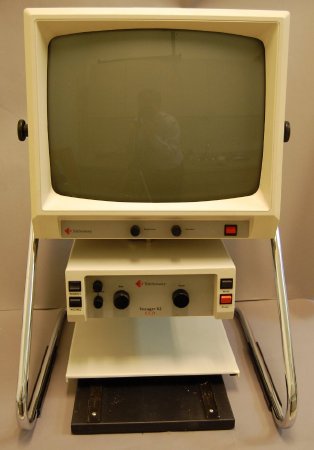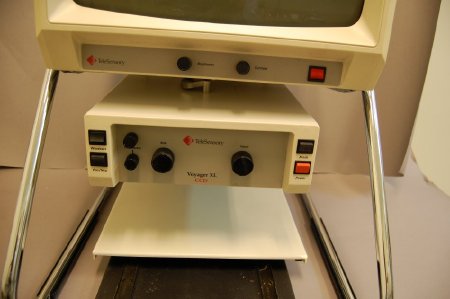Object ID:
2014.30
Title:
Voyager XL CCD Video Magnifier
Creator:
Telesensory
Description:
(a) camera unit: putty colored aluminum case with cream plastic face trim; chrome-plated steel stand on back supports camera unit above black aluminum base; putty plastic table maneuvers under the camera on steel track system; control panel on front of camera unit has two toggles on left--windows and positive/negative--four dials in center controlling magnification, focus, and line markers, and two toggles on right control mode and power; screened in red and black on front, "Voyager XL CCD"; reverse of unit has power cable, video in and out coaxial jacks, a balance knob, a positive/negative toggle, and an M19 coaxial jack with cable; on manufacturer's label, "SN# CC9101-110 Model No. XL3A"; (b) monitor stand: chrome plated tubular steel stand with three black plastic pads on base; open at front to hold monitor over camera unit; two black plastic knobs on side wings secure the monitor to the stand; (c) TV monitor: putty colored square aluminum case with gray plastic carrying handle on top; cream plastic trim around curved glass picture tube; brightness and contrast knobs below screen with red power on/off toggle; on reverse is three-prong power jack and M19 coaxial jack along with auxiliary power toggle; adhesive label on right (proper) side, "Telesensory 19-inch Monitor Serial No. MC9103-126 Model No. M-19".
Dimensions:
H-30 W-21.5 D-21 inches
Date:
ca. 1985
Made by:
Telesensory, Visualtek
Place of Origin:
Gardena, CA; Santa Monica, CA
Provenance:
Purchased second-hand by the donor, Pat Humphrey, circa 1985 from a Louisville Telesensory dealer, Dick Barnett, for $3,000. Low vision all her life, by the time she entered high school it had deteriorated to the point that she "couldn't read the blackboard." Humphrey hid her visual abilities and remembered that "lots of people did not know I was blind." She even drove a car, "though I knew I shouldn't." After making do with hand held magnifiers for years, she was delighted to acquire this unit, using it to read her mail and write checks.
The first CC-TV units were developed by Samuel Genensky and his team at the Rand Corporation in the late 1960s. By the early 1980s, there were a variety of models on the market. The Voyager was a brand of Visualtek in Santa Monica, CA. It was bought by Telesensory in 1989. Telesensory Systems was a leading accessibility technology firm founded in 1970 at Stanford University. By the 1980s they were beginning to focus exclusively on low vision products like the Voyager.
The first CC-TV units were developed by Samuel Genensky and his team at the Rand Corporation in the late 1960s. By the early 1980s, there were a variety of models on the market. The Voyager was a brand of Visualtek in Santa Monica, CA. It was bought by Telesensory in 1989. Telesensory Systems was a leading accessibility technology firm founded in 1970 at Stanford University. By the 1980s they were beginning to focus exclusively on low vision products like the Voyager.
Credit Line:
Gift of Pat Humphrey, 2014.30.

